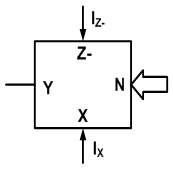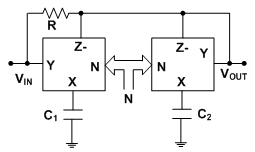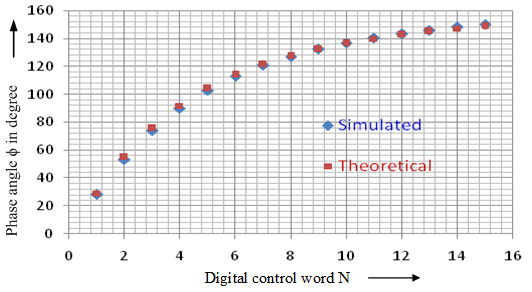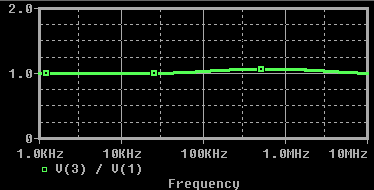Iqbal A. Khan , Ahmed M. Nahhas
Department of Electrical Engineering, Faculty of Engineering and Islamic Architecture, Umm Al Qura University, Makkah, Saudi Arabia
Correspondence to: Iqbal A. Khan , Department of Electrical Engineering, Faculty of Engineering and Islamic Architecture, Umm Al Qura University, Makkah, Saudi Arabia.
| Email: |  |
Copyright © 2012 Scientific & Academic Publishing. All Rights Reserved.
Abstract
The low voltage digitally controlled current conveyors have been used to realize the digitally controlled reconfigurable continuous time first order voltage mode phase shifters. Each of the realized phase shifters uses two digitally controlled current conveyers along with three passive elements. The realized phase shifters provide digital control to phase angle through an n-bit digital control word. The realized digitally controlled continuous time phase shifters are designed and verified using PSPICE and the results thus obtained justify the theory.
Keywords:
Current Conveyors, Phase Shifter, Filter
1. Introduction
Introduction of digital control to the current conveyor (CCII) has boosted its functional flexibility and versatility in addition to its higher signal bandwidth, greater linearity and large signal bandwidth[1-10]. This digital control has eased the on chip control of continuous time systems through digital word with high resolution capability and reconfigurability[1-5],[10].This paper basically deals with the realization of reconfigurable continuous time first order voltage mode phase shifters using Low voltage digitally controlled CCII. Each of the realized phase shifters uses two digitally controlled current conveyors along with three passive elements. The realized phase shifters provide digital control to phase angle through an n-bit digital control word. To verify the theory, the realized digitally controlled continuous time phase shifters are designed and verified using PSPICE and the results thus obtained justify the theory.
2. The Circuit
The digitally controlled CCII symbol is shown in “Figure 1(a)” and its CMOS implementation with 4-bit control is shown in “Figure 1(b)”. The current summing network (CSN) is included at port-X[1-4],[9],[10]. The transfer matrix can be expressed as follows. | (1) |
Thus the port voltages and currents for the digitally programmable current conveyor (DPCCII) can be expressed as IY = 0, VX = VY and  | (2) |
where, N is an n-bit digital control word. The voltage mode phase shifters using low voltage digitally controlled CMOS DPCCII are shown in “Figure 2”. The DPCCII- uses the CSN at port-Z- as shown in “Figure 1(b)”. The routine analysis yields the voltage transfers function for the reconfigurable phase shifter-I of “Figure 2(a)” as  | Figure 1(a). Symbol for 4-bit DPCCII- |
 | Figure 1(b). The CMOS implementation of a 4-bit DPCCII- with CSN at port Z- |
The voltage mode phase shifters using low voltage digitally controlled CMOS DPCCII are shown in “Figure 2”. The DPCCII- uses the CSN at port-Z- as shown in “Figure 1(b)”. The routine analysis yields the voltage transfers function for the reconfigurable phase shifter-I of “Figure 2(a)” as  | (3) |
 | Figure 2(a). The reconfigurable phase shifter-I |
 | Figure 2(b). The reconfigurable phase shifter-II |
With R1 = R2 = R, the phase shift angle | (4) |
Similarly, the voltage transfers function for the reconfigurable phase shifter-II of “Figure 2(b)” can be expressed as  | (5) |
With C1 = C2 = C, the phase shift angle | (6) |
It is thus evident from equations (4) and (6) that the phase angle between output and input of the two phase shifters can be controlled with the digital control word N.
3. The Effect of Non-Idealities
Taking the non-idealities of CCIIs into account, the relationship of the terminal voltages and currents can be rewritten as: | (7) |
Where, in equation (7) βk is the voltage transfer gain from terminal-Y to terminal-X for the kth CCII and αk is the current transfer gains for kth CCII from X to Z- respectively. Using equation (7) the ideal transfer functions and the phase angles given in (3), (4) and (5), (6) respectively for the circuit of” Figure 1(a)” and “Figure 1(b)”, yields the non-ideal transfer functions and the phase shifts as follows.  | (8) |
With α1 = α2 = α and β1 = β2 = β | (9) |
 | (10) |
Again with α1 = α2 = α and β1 = β2 = β | (11) |
From equations (8) through (11) it is evident that the phase angles are affected slightly due to the non idealities.
4. Design and Verification
The realized digitally controlled current mode first order phase shifter of “Figure 2(a)”, was designed and verified by performing PSPICE simulation with supply voltage ± 0.75V using CMOS TSMC 0.25μm technology parameters. The CMOS DPCCII with 4-bit current summing network at port-Z- of “Figure 1(b)” was used. The aspect ratios used are given in the Table 1. Initially the phase shifter was designed for a phase angle  =290 at a constant frequency f0 = 100 KHz with N = 1. Assuming C= 1nF, equation (4) yields R = 6.36KΩ. Then the phase angle
=290 at a constant frequency f0 = 100 KHz with N = 1. Assuming C= 1nF, equation (4) yields R = 6.36KΩ. Then the phase angle  was controlled through digital control word N. The variation of observed and the theoretical phase angles with different control words ‘N’ at f0 = 100KHz are given in “Figure 3”. The transfer gain and the input, output wave shapes at N = 4 are shown in “Figure 4”. The variation of phase angle with frequency at different digital control word ‘N’ is shown in “Figure 5”. Thus the results of “Figure 3” through “Figure 5” clearly confirm the close conformity with the theory.
was controlled through digital control word N. The variation of observed and the theoretical phase angles with different control words ‘N’ at f0 = 100KHz are given in “Figure 3”. The transfer gain and the input, output wave shapes at N = 4 are shown in “Figure 4”. The variation of phase angle with frequency at different digital control word ‘N’ is shown in “Figure 5”. Thus the results of “Figure 3” through “Figure 5” clearly confirm the close conformity with the theory.  | Figure 3. Phase angle variation with digital control word N at a constant frequency f 0 = 100 KHz |
 | Figure 4(a). Gain Vs frequency response of the DCPS1 at N = 4 |
 | Figure 4(b). The input VIN and output VOUT wave shapes at f =100KHz and N = 4 |
 | Figure 5. The phase vs frequency response at different digital control word N |
| Table 1. The aspect ratios of the MOSFETs of the DPCCII |
| | MOSFETs | W μm | L μm | | M1, M2, M5, M6 | 5 | 0.25 | | M3, M4, M7, M8 | 0.5 | 0.5 | | M9, M10 | 0.5 | 0.25 | | M11, M12, M13, M14,M15, M16,M17, M18,M19, M23, M27, M31 | 25 | 0.25 | | M20, M24, M28, M32 | 50 | 0.25 | | M21, M25, M29, M33 | 100 | 0.25 | | M22, M26, M30, M34 | 200 | 0.25 |
|
|
5. Conclusions
Two new voltage mode digitally controlled first order phase shifters have been realized using low voltage digitally controlled CMOS current conveyors. Each of the realized phase shifters uses two digitally controlled current conveyers along with three passive elements. The realized phase shifters provide digital control to phase angle through an n-bit control word. The realized digitally controlled continuous time phase shifters were designed and verified using PSPICE and the results thus obtained justify the theory.
References
| [1] | T. M. Hassan and S. A. Mahmoud, "Low voltage digitally programmable band pass filter with independent control," IEEE International Conference on Signal Processing and Communications (ICSPC 2007), pp. 24-27, Dubai, UAE, 2007. |
| [2] | I. A. Khan, M. R. Khan and N. Afzal, "Digitally programmable multifunctional filters using CCIIs," Journal of Active and Passive Electronic Devices, vol. 1, pp.213-220, 2006. |
| [3] | I. A. Khan, M. R. Khan and N. Afzal, "A Digitally Programmable Impedance Multiplier using CCIIs with High Resolution Capability," Journal of Active and Passive Electronic Devices, vol. 8, pp. 247-257, 2009. |
| [4] | T. M. Hassan and S. A. Mahmoud, "Fully programmable universal filter with independent gain, ω0 and Q control based on new digitally programmable CMOS CCII," Journal of Circuits, Systems and Computers, Vol. 18, No. 5, pp.875-897, 2009. |
| [5] | S. A. Mahmoud, M. A. Hashiesh, and A. M. Soliman, "Low-Voltage Digitally Controlled Fully Differential Current Conveyor," IEEE Transactions on circuits and Systems-I, vol. 52, No. 10, 2005. |
| [6] | I. A. Khan, and S. Maheshwari, "Simple first order all-pass section using a single CCII," International Journal of Electronics, vol. 87, No. 3, pp. 303-306, 2000. |
| [7] | R. Mita, G. Palumbo, and S. Pennisi, "1.5-V CMOS CCII+ with High Current-Drive Capability," IEEE Trans. CAS-II, vol. 50, No. 4, pp. 187-190, 2003. |
| [8] | A. H. Madian, S. A Mahmoud and A. M. Soliman, "New 1.5V CMOS second generation current conveyor based on wide range transconductor," Analog Integrated Circuits and Signal Processing, vol. 49, pp. 267-279, 2006. |
| [9] | I. A. Khan, P. Beg and M. T. Ahmed, "First Order Current Mode Filters and Multiphase Sinusoidal Oscillators Using MOCCIIs", Arabian Journal of Science and Engineering, Saudi Arabia, vol.32, No. 2C, pp. 119-126, Dec. 2007. |
| [10] | I. A. Khan and M. T Simsim, "A Novel Impedance Multiplier using Low voltage Digitally Controlled CCII," Proc. IEEEE GCC Conference and Exhibition, Dubai, UAE, pp. 331-334, Feb. 19-22, 2011. |
















 =290 at a constant frequency f0 = 100 KHz with N = 1. Assuming C= 1nF, equation (4) yields R = 6.36KΩ. Then the phase angle
=290 at a constant frequency f0 = 100 KHz with N = 1. Assuming C= 1nF, equation (4) yields R = 6.36KΩ. Then the phase angle  was controlled through digital control word N. The variation of observed and the theoretical phase angles with different control words ‘N’ at f0 = 100KHz are given in “Figure 3”. The transfer gain and the input, output wave shapes at N = 4 are shown in “Figure 4”. The variation of phase angle with frequency at different digital control word ‘N’ is shown in “Figure 5”. Thus the results of “Figure 3” through “Figure 5” clearly confirm the close conformity with the theory.
was controlled through digital control word N. The variation of observed and the theoretical phase angles with different control words ‘N’ at f0 = 100KHz are given in “Figure 3”. The transfer gain and the input, output wave shapes at N = 4 are shown in “Figure 4”. The variation of phase angle with frequency at different digital control word ‘N’ is shown in “Figure 5”. Thus the results of “Figure 3” through “Figure 5” clearly confirm the close conformity with the theory. 



 Abstract
Abstract Reference
Reference Full-Text PDF
Full-Text PDF Full-Text HTML
Full-Text HTML